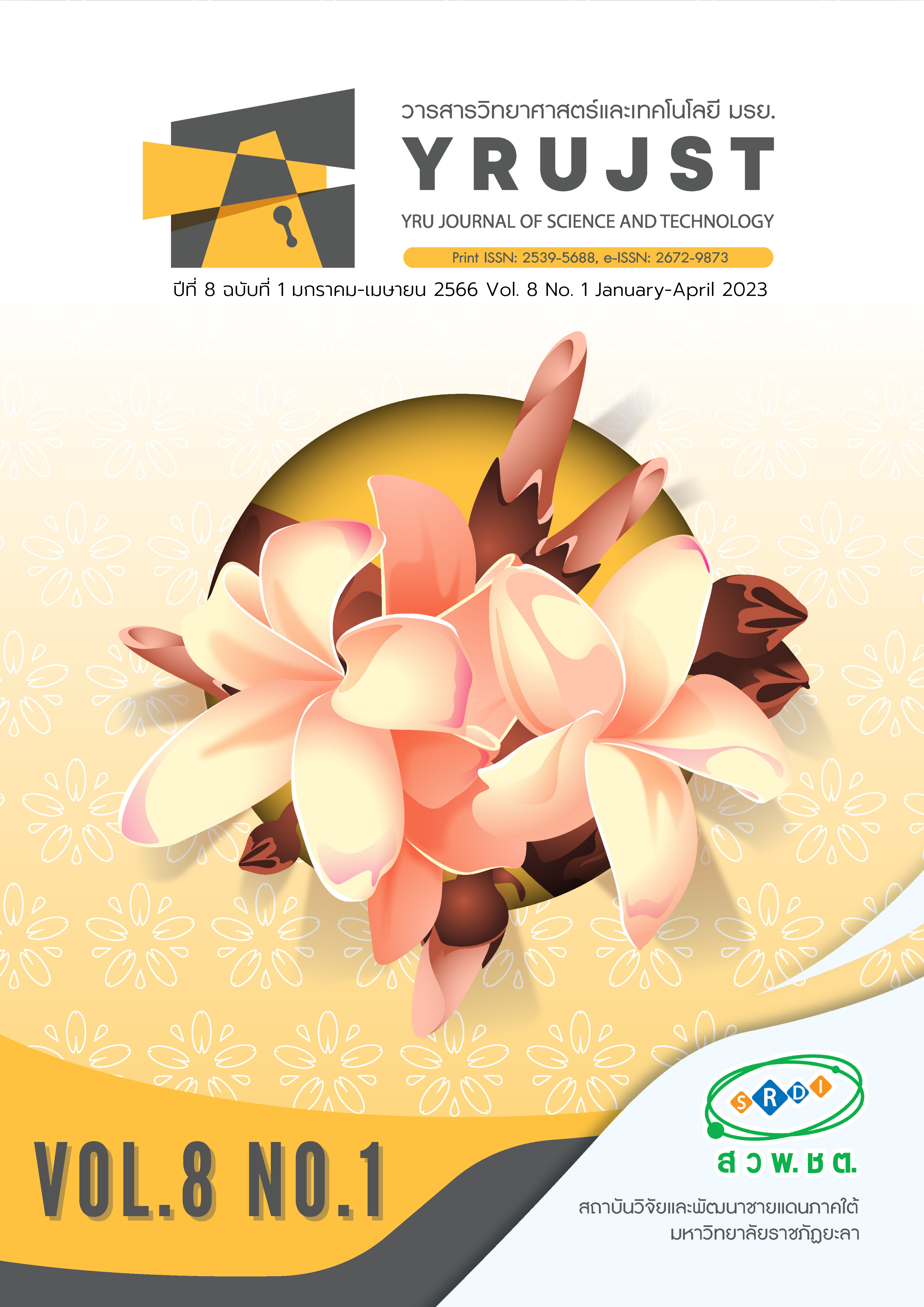Biodegradable Plant Pots from Bacterial Cellulose Production by Komagataeibacter nataicola TISTR 975 from Agricultural Waste Materials
Main Article Content
Abstract
Currently, there is a large amount of agricultural wastes which are the environmental problems. The objective of this research was to develop the production of bacterial cellulose sheets by Komagataeibacter nataicola TISTR 975 from agricultural wastes which are low-cost substrates including melon peel juice, corncob juice, sugarcane bagasse juice, water hyacinth juice and coconut water for biodegradable plant pots production. When comparing the thickness of bacterial cellulose sheets from K. nataicola TISTR 975, the highest thickness of bacterial cellulose sheets was found in coconut water followed by melon peel juice and corncob juice respectively. Those bacterial cellulose sheets had tensile strength of 37.8-79.1 MPa. Fourier Transform Infrared Spectroscopy (FT-IR) showed the chemical structure of cellulose. Scanning electron microscope (SEM) morphology showed a fibril network, and began to decompose at 215-300 ºC. Bacterial cellulose sheets produced from 3 types of low-cost substrates were studied on characterization and molding biodegradable plant pots. The result showed that the rate of water absorption of the pots was 257-558 % and they were completely biodegraded within 30 days. Therefore, the bacterial cellulose sheets produced using K. nataicola TISTR 975 was able to used for biodegradable plant pot production.
Article Details

This work is licensed under a Creative Commons Attribution-NonCommercial-NoDerivatives 4.0 International License.
บทความ ข้อมูล เนื้อหา รูปภาพ ฯลฯ ที่ได้รับการเผยแพร่ในวารสารวิทยาศาสตร์และเทคโนโลยี มรย. นี้ ถือเป็นลิขสิทธิ์ของวารสารวิทยาศาสตร์และเทคโนโลยี มรย. หากบุคคลหรือหน่วยงานใดต้องการนำทั้งหมดหรือส่วนหนึ่งส่วนใดไปเผยแพร่ต่อหรือกระทำการใดๆ จะต้องได้รับอนุญาตเป็นลายลักษณ์อักษรจากวารสารวิทยาศาสตร์และเทคโนโลยี มรย. ก่อนเท่านั้น
References
Bunnag, N. (2021). Agricultural plastic residues in the soil harm to food security, health, and environment [Online]. Retrieved February 14, 2023, from: https://www.sdgmove.com/2021/12/09/plastics-in- soil-threaten-food-security-health-and-environment-fao/ (in Thai)
Bunyakan, M. (2017). Production of nata de coco for processing of a gac drink mixed with nata de coco and dehydrated sweetened nata de coco. KKU Sci. J., 45(3), 501-512. (in Thai)
Dikshit, P. K. & Kim, B. S. (2020). Bacterial cellulose production from biodiesel–derived crude glycerol, magnetic functionalization, and its application as carrier for lipase immobilization. International Journal of Biological Macromolecules, 153, 902–911.
Doree, L. M., Dobre, T. & Ferdes, T. M. (2012) Biodegradation kinetics of antimicrobial composite films based on polyvinyl alcohol-bacterial cellulose. REV. CHIM. (Bucharest), 63(5), 540-544.
Food and Agriculture Organization of the United Nations. (2021). Assessment of agricultural plastics and their sustainability. A call for action. Italy: FAO.
Jaturapiree, A., Chaichana, E., Saowapark, T., Chuenpraphai, B. & Jaturapiree, P. (2019). Production and characteri[ation of bacterial cellulose produced by Acetobacter xylinum TISTR 975 from pineapple peel juice. RMUTP Research Journal, 13(1), 180-192. (in Thai)
Jia, Yuanyuan., Wang, X., Huo, M., Zhai, X., Li, F. & Zhong, C. (2017). Preparation and characterization of a novel bacterial cellulose/chitosan bio-hydrogel. Nanomaterials and Nanotechnology, 7, 1–8.
Khemacheewakul, J. (2017). Factors affecting production of cellulose Acetobacte sp. and fermentation technology. RMUTSB Acad. J., 5(1), 91-103-192. (in Thai)
Land Development Department. (2021). Agri-Map YALA. Bangkok: Land Development Department. (in Thai)
Li. G., Nandgaonkar, A. G., Habibi, Y., Krause, W. E., Wei, Q. & Lucia, L. A. (2017). An environmentally benign approach to achieving vectorial alignment and high microporosity in bacterial cellulose/chitosan scaffolds. RSC Adv., 7, 13678-13688.
Maryam, M., Dedy, R. & Yunizurwan, Y. (2017). Processing of micro-nano bacterial cellulose with hydrolysis method as a reinforcing bioplastic. IOP Conf. Series: Journal of Physics: Conf. Series, 795, 1-7.
Mohd Rafee, S. N. A., Lee, Y. L., Jamalludin, M. R., Razak, N. A., Makhtar, N. l. & Ismail, R. I. (2019). Effect of different ratios of biomaterials to banana peels on the weight loss of biodegradable pots. Acta Technologica Agriculturae 1/2019. DOI: 10.2478/ata-2019-0001
Paditsrikun, N. (2015). Quality of bacterial cellulose from different nutrient cultured in extracted corn juice. Bachelor´s project. Rajamangala University of Technology Suvarnabhumi. (in Thai)
Paoprasert, P. (2013). Polymers from biological sources: A Literature Review. KKU Res. J., 18(3), 536-547. (in Thai)
Piyang, T., Chaichan, W. & Sagulsawasdipan, K. (2018). Environment-friendly plant pot production from palm oil sludge and mushroom cultured waste. RMUTSV Research Journal, 10(3), 497-511. (in Thai)
Nilsang, P. & Kholungkul, J. (2017). Development of bacterial cellulose production from herbal juices. VRU Research and Development Journal Science and Technology, 1(3), 123-134. (in Thai)
Schröpfer, S. B., Bottene, M. K., Bianchin, L., Robinson, L. C. Lima, V. D., Jahno, V. D. Barud, H. D. S. & Ribeiro, S. J. L. (2015). Biodegradation evaluation of bacterial cellulose, vegetable cellulose and poly (3-hydroxybutyrate) in soil. Polímeros, 25(2), 154-160.
Singhsa, P. Narain R. & Manuspiya, M. (2018). Bacterial cellulose nanocrystals (BCNC) preparation and characterizations from three bacterial cellulose sources, and development of functionalized BCNC as nucleic acid delivery systems. ACS Applied Nano Materials, 1, 209-221.
United Nations. (2021). Plastics in soil threaten food security, health, and environment: FAO. [Online]. Retrieved March 14, 2023, from : https://news.un.org/en/story/2021/12/1107342
Yim, S. M., Song J. E. & Kim, H. R. (2017). Production and characterization of bacterial cellulose fabrics by nitrogen sources of tea and carbon sources of sugar, Process Biochemistry, 59, 26-36.


